

The Baroncelli Chapel is a chapel located at the end of the right transept in church of Santa Croce, central Florence, Italy.
Contents
It has frescoes by Taddeo Gaddi executed between 1328 and 1338.


The Baroncelli Chapel is a chapel located at the end of the right transept in church of Santa Croce, central Florence, Italy.
It has frescoes by Taddeo Gaddi executed between 1328 and 1338.
The fresco cycle represents the Stories of the Virgin. In this work, Gaddi showed his mastership of Giotto's style, with a narrative disposition of the characters in the scenes, which are more crowded than his master's. He also continued to experiment with the use of geometrical perspective in the architectural background, obtaining illusionistic effects in details such as the oblique staircase in the Presentation at the Temple.
The two niches with still lifes in the basement are perhaps inspired by Giotto's ones in the Scrovegni Chapel.
The delicate and soft features are characteristic of Gaddi's late style. The adoption of night light in the Annunciation to the Shepherds is nearly unique in the mid-14th century painting of central Italy.
Gaddi also designed the stained glasses, with four prophets on the exterior, and perhaps had a hand in the altarpiece also: this, dating to c. 1328, has the signature Opus Magistri Jocti, but the style shows the hands of assistants, including Gaddi himself. It is an elaborate polyptych, depicting the Coronation of the Virgin surrounded by a crowded Glory of Angels and Saints. The cusp of the altarpiece is now at the San Diego Museum of Art of San Diego, California, United States. The original frame was replaced by a new one during the 15th century.
Other artworks in the chapel include, on the right wall, a Madonna of the Cintola by Sebastiano Mainardi.
The Baroncelli Polyptych, painted by Giotto di Bondone c.1334, is in the chapel.
The Baroncelli family owned the tomb on the external wall, which was designed by Giovanni di Balduccio in 1327. He also sculpted the statuettes of the Archangel Gabriel and the Annunciation on the arcade's pillars.
The "Madonna with Child" sculpture inside the chapel was created by Vincenzo Danti in 1568.
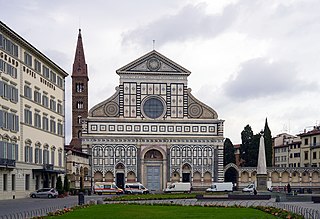
Santa Maria Novella is a church in Florence, Italy, situated opposite, and lending its name to, the city's main railway station. Chronologically, it is the first great basilica in Florence, and is the city's principal Dominican church.

Lorenzo Monaco was an Italian painter and miniaturist of the late Gothic to early Renaissance age. He was born Piero di Giovanni. Little is known about his youth, apart from the fact that he was apprenticed in Florence. He has been considered the last important exponent of the Giotto style, before the Renaissance revolution that came with Fra Angelico and Masaccio.

Taddeo Gaddi was a medieval Italian painter and architect.

Agnolo Gaddi (c.1350–1396) was an Italian painter. He was born and died in Florence, and was the son of the painter Taddeo Gaddi, who was himself the major pupil of the Florentine master Giotto.

Pietro Lorenzetti or Pietro Laurati was an Italian painter, active between c. 1306 and 1345. Together with his younger brother Ambrogio, he introduced naturalism into Sienese art. In their artistry and experiments with three-dimensional and spatial arrangements, the brothers foreshadowed the art of the Renaissance.

The Basilica di Santa Croce is a minor basilica and the principal Franciscan church of Florence, Italy. It is situated on the Piazza di Santa Croce, about 800 metres southeast of the Duomo, on what was once marshland beyond the city walls. Being the burial place of notable Italians, including those from the Italian Renaissance such as Michelangelo, Galileo, and Machiavelli, as well as the poet Foscolo, political philosopher Gentile and the composer Rossini, it is also known as the Temple of the Italian Glories.

The Badìa Fiorentina is an abbey and church now home to the Monastic Communities of Jerusalem situated on the Via del Proconsolo in the centre of Florence, Italy. Dante supposedly grew up across the street in what is now called the 'Casa di Dante', rebuilt in 1910 as a museum to Dante. He would have heard the monks singing the Mass and the Offices here in Latin Gregorian chant, as he famously recounts in his Commedia: "Florence, within her ancient walls embraced, Whence nones and terce still ring to all the town, Abode aforetime, peaceful, temperate, chaste." In 1373, Boccaccio delivered his famous lectures on Dante's Divine Comedy in the subsidiary chapel of Santo Stefano, just next to the north entrance of the Badia's church.
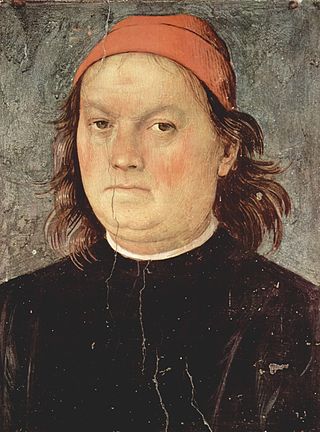
Pietro Perugino, an Italian Renaissance painter of the Umbrian school, developed some of the qualities that found classic expression in the High Renaissance. Raphael became his most famous pupil.
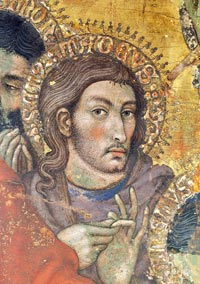
Taddeo di Bartolo, also known as Taddeo Bartoli, was an Italian painter of the Sienese School during the early Renaissance. His biography appears in the Vite of Giorgio Vasari, who claims that Taddeo was the uncle of Domenico di Bartolo.

Bernardo Daddi was an early Italian Renaissance painter and the leading painter of Florence of his generation. He was one of the artists who contributed to the revolutionary art of the Renaissance, which broke away from the conventions of the preceding generation of Gothic artists, by creating compositions which aimed to achieve a more realistic representation of reality. He was particularly successful with his small-scale works and contributed to the development of the portable altarpiece, a format that subsequently gained great popularity.

Giovanni da Milano was an Italian painter, known to be active in Florence and Rome between 1346 and 1369.

The Basilica della Santissima Annunziata del Vastato is the Catholic cathedral of Genoa, northern Italy; its decoration employed the major baroque studios and artists in Genoa in the 17th century.

Florentine painting or the Florentine school refers to artists in, from, or influenced by the naturalistic style developed in Florence in the 14th century, largely through the efforts of Giotto di Bondone, and in the 15th century the leading school of Western painting. Some of the best known painters of the earlier Florentine School are Fra Angelico, Botticelli, Filippo Lippi, the Ghirlandaio family, Masolino, and Masaccio.

Maso di Banco was an Italian painter of the 14th century, who worked in Florence, Italy. He and Taddeo Gaddi were the most prominent Florentine pupils of Giotto di Bondone, exploring the three-dimensional dramatic realism inaugurated by Giotto.
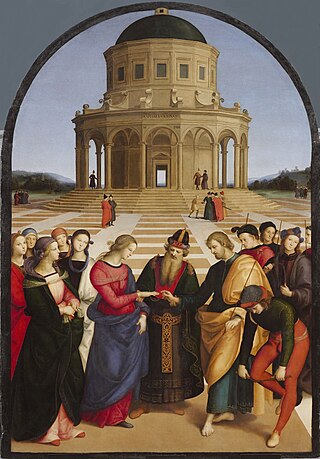
Italian Renaissance painting is the painting of the period beginning in the late 13th century and flourishing from the early 15th to late 16th centuries, occurring in the Italian Peninsula, which was at that time divided into many political states, some independent but others controlled by external powers. The painters of Renaissance Italy, although often attached to particular courts and with loyalties to particular towns, nonetheless wandered the length and breadth of Italy, often occupying a diplomatic status and disseminating artistic and philosophical ideas.
The decade of the 1320s in art involved some significant events.
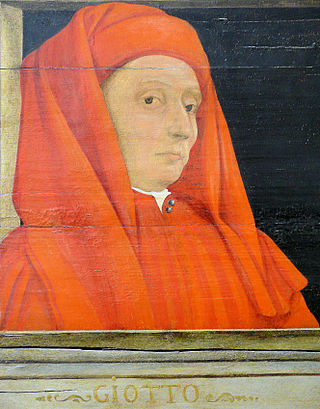
Giotto di Bondone, known mononymously as Giotto and Latinised as Giottus, was an Italian painter and architect from Florence during the Late Middle Ages. He worked during the Gothic and Proto-Renaissance period. Giotto's contemporary, the banker and chronicler Giovanni Villani, wrote that Giotto was "the most sovereign master of painting in his time, who drew all his figures and their postures according to nature" and of his publicly recognized "talent and excellence". Giorgio Vasari described Giotto as making a decisive break from the prevalent Byzantine style and as initiating "the great art of painting as we know it today, introducing the technique of drawing accurately from life, which had been neglected for more than two hundred years".

The Bartolini Salimbeni Chapel is a chapel in the church of Santa Trinita, Florence, central Italy. Its decoration by Lorenzo Monaco, dating to the 1420s, are one of the few surviving examples of International Gothic frescoes in Italy. The chapel has kept other original elements, such as its altarpiece, an Annunciation, also by Monaco, and the railings.
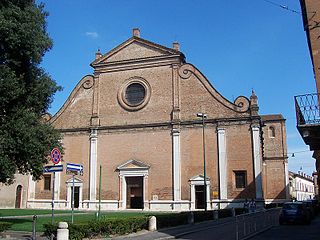
San Francesco is a late-Renaissance, Roman Catholic minor basilica church located on via Terranuova in Ferrara, Emilia-Romagna, Italy.

San Fortunato is a Gothic- and Renaissance-style, Roman Catholic church located on Piazza Umberto I #6 in the historic center of Todi, province of Perugia, region of Umbria, Italy.